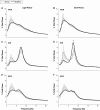Musculoskeletal sensitization and sleep: chronic muscle pain fragments sleep of mice without altering its duration
- PMID: 24587573
- PMCID: PMC3920316
- DOI: 10.5665/sleep.3486
Musculoskeletal sensitization and sleep: chronic muscle pain fragments sleep of mice without altering its duration
Abstract
Study objectives: Musculoskeletal pain in humans is often associated with poor sleep quality. We used a model in which mechanical hypersensitivity was induced by injection of acidified saline into muscle to study the impact of musculoskeletal sensitization on sleep of mice.
Design: A one month pre-clinical study was designed to determine the impact of musculoskeletal sensitization on sleep of C57BL/6J mice.
Methods: We instrumented mice with telemeters to record the electroencephalogram (EEG) and body temperature. We used an established model of musculoskeletal sensitization in which mechanical hypersensitivity was induced using two unilateral injections of acidified saline (pH 4.0). The injections were given into the gastrocnemius muscle and spaced five days apart. EEG and body temperature recordings started prior to injections (baseline) and continued for three weeks after musculoskeletal sensitization was induced by the second injection. Mechanical hypersensitivity was assessed using von Frey filaments at baseline (before any injections) and on days 1, 3, 7, 14, and 21 after the second injection.
Results: Mice injected with acidified saline developed bilateral mechanical hypersensitivity at the hind paws as measured by von Frey testing and as compared to control mice and baseline data. Sleep during the light period was fragmented in experimental mice injected with acidified saline, and EEG spectra altered. Musculoskeletal sensitization did not alter the duration of time spent in wakefulness, non-rapid eye movement sleep, or rapid eye movement sleep.
Conclusions: Musculoskeletal sensitization in this model results in a distinct sleep phenotype in which sleep is fragmented during the light period, but the overall duration of sleep is not changed. This study suggests the consequences of musculoskeletal pain include sleep disruption, an observation that has been made in the clinical literature but has yet to be studied using preclinical models.
Keywords: Musculoskeletal sensitization; mechanical hypersensitivity; sleep fragmentation.
Figures



References
-
- Jacobs T. No pain, no gain? Nat Biotechnol. 2005;23:934. - PubMed
-
- Dagenais S, Caro J, Haldeman S. A systematic review of low back pain cost of illness studies in the United States and internationally. Spine J. 2008;8:8–20. - PubMed
-
- Phillips CJ, Harper C. The economics associated with persistent pain. Curr Opin Support Palliat Care. 2011;5:127–30. - PubMed
-
- Sprangers MA, de Regt EB, Andries F, et al. Which chronic conditions are associated with better or poorer quality of life? J Clin Epidemiol. 2000;53:895–907. - PubMed
-
- Effect of short sleep duration on daily activities--United States, 2005-2008. Morb Mortal Wkly Rep. 2011;60:239–42. - PubMed
Publication types
MeSH terms
LinkOut - more resources
Full Text Sources
Other Literature Sources

